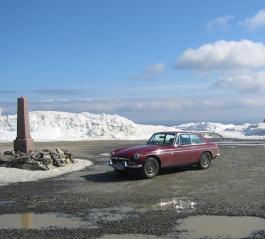
|
V8
Newsletter TE
low brake fluid detector - a vital safety device for an MGBGTV8 |
you the earliest warning that you should stop the car as soon as possible. The TE low brake fluid sensor kit can be used with 12V negative or positive earth cars and fits only the metal type of Lockheed brake fluid reservoir with either the original metal cap or the later nylon cap we see on V8s. A variant of the sensor is being produced for the later plastic replacement brake fluid reservoirs. It will also be useful for the many more MGB and MGC enthusiasts in the UK and overseas. The kit comes in a pack with all the parts and comprehensive fitting instructions together with a copy of a V8NOTE33 which describes the author's experience of fitting one of the kits in a V8. By the way V8NOTE331 is the first V8 Workshop Note in the new Volume 10 of the long running and popular series based on members' spares and maintenance tips. 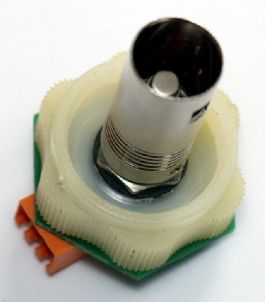 Neat electronic sensor under the cap of the brake fluid reservoir monitors the brake fluid. (Photo: Bob Owen) The alarm signal is a rapid flashing of the LED plus synchronised bleeping. At switch-on of the ignition there is a short flash/beep to indicate that the sensor is active. The sensor operation is thermal. The sensor element is a small metal cased device 5mm dia x3mm which is surrounded by a larger metal protective shroud attached to the cap. The alarm goes off within 1.5 minutes if fluid doesn't surround the sensor. The delayed response makes the unit proof against false alarms from fluid displacement such as might occur when cornering or braking hard. The electronics are built onto a hexagonal pcb which takes the place of the push-on lid on the standard plastic cap. The components are mostly surface mount (ultra miniature) types which fit into the void in the cap. The pcb has a 0.6mm dia vent hole which communicates to the reservoir via a small slot in the sensor connector assembly, simulating the original vent path. The three wires to the unit (chassis, +12V and Indicator) are connected to a plug so that the cap/sensor is easily removed to top up fluid levels. The unit is protected against surge voltages, reverse connection and short circuit of the LED indicator/bleeper or cabling. The aim is for simple and foolproof installation! |
||||
| North
Cape - V8 experiences Theo Klick (Damask 1721) and Claus Esser, two V8 enthusiasts in Germany, recount an extraordinary journey in an MGBGTV8 to the northern tip of Norway and back earlier this year. The speedometer of the V8 was showing 88,722 miles when Theo and I left the Rhineland on 6th May. Our aim was to reach the northernmost point of Europe: North Cape. We reached the Danish border around 1am driving via Bremen, Hamburg and Flensburg and, following the E45 northwards, took a break after nearly 1,000km just as day was breaking at the Hirtshals lighthouse. The ship, MS Color Festival, left harbour with us on board on the dot at 10 towards Oslo. The eight hour crossing was calm and we arrived well rested in the Norwegian capital at 6pm. 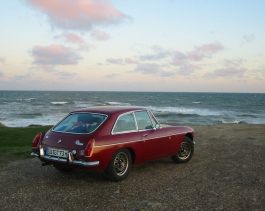 The beach at Hirtshals - Damask 1721 - owned by Theo Klick (Photo: Tero Klick) With
Norwegian ground under the wheels of our 31 year old V8, we
left the labyrinth of Oslo on the E6. The first impressions of Scandinavia
were collected at on the way to a camping ground at Tangen. The
camp huts, which are usually very comfortable, make an excellent
alternative to the simple but expensive hotels beside the E6. Our
first day on Scandinavian soil was celebrated with one of the few
beer cans which we had brought with us - a maximum of 2ltr per person!.
The V8 started perfectly the following morning and we continued
on past the Olympic town of Lillehammer. Dombras greeted us with
light hail and a series of hairpins took us up to the 1,700 Meter
plateau of Dovrefjell. The hail had meanwhile turned to a full-scale
snowstorm which continued to make for a slow drive through a winter-wonderland
past Oppdal. The snow eased off and we arrived at Trondheim with
clear skies in the late afternoon. An amazing view of Trondheim
fjord more than made up for the drive through snow and fog. We crossed
latitude 64 at Steinkjer and settled for a simple motel on the banks
of the Snasavatnet. |
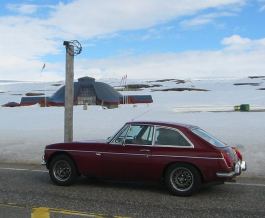 Damask 1721 crossing the Artic Circle. (Photo: Theo Klick) We reached Narvik, a famous port where iron ore from the Swedish mines at Kiruna is loaded. The E6 continues beyond Narvik up through snow covered passes and the weather became changeable with a mixture of sun, snow and rain. The empty roads and the V8 engine stretched the old chassis design from Abingdon to the limit on the poor road surface. We passed Tromso and stayed for the night at a simple campsite with a lovely view over Kvaenang fjord at Nordeisa. Driving along Alta fjord we reached the Finnmark (northernmost region of Norway) with the V8 purring. Again we were offered fantastic scenery formed by glaciers during the last ice age. In overdrive at nearly 80 mph we crossed latitude 70 and the Sennalandet plateau. In order to visit Hammerfest, the most northerly town of the world, we briefly left the E6 and spent the night in Skaidi. Theo gave me the honour of driving the V8 with glorious weather and empty roads to our destination: the northernmost tip of continental Europe. We reached Mageroy island through a 200m deep tunnel. We arrived at the North Cape after 6 days and 3,500km around lunchtime in bright sunshine and parked "Damask 1721" (perfectly prepared by Rainer Pfeiffer) in front of the granite column of the modern North Cape Centre. At this point (71°10'21''N), with a bitter North wind blowing, we unfolded our OVFW-Club flag and slowly got ready for departure. After a short visit to the idyllic fishing village of Honningsvag, we dropped into the "American-Car-Club Nordkapp" then left Mageroy island. However, a sudden judder from the V8 stopped our journey in the middle of nowhere. A handful of reindeer watched our repair work. The defect was fairly simple: the condenser had given up the ghost but thanks to Theo's well sorted spares box the car returned to its normal reliable self very quickly. We spent the night in Skaidi before continuing to Karasjok (seed centre of Finnmark) where we had the fuel gauge repaired then rejoined the E6 at Alta. The route South from Storslett to Bjerkvik was on known roads until we turned off in the direction of Lofoten (E10). At 70-80mph we made good progress until the Norwegian weather started to play games again. With light snow showers we arrived at the harbour of Melbu on the Vesteraelen. A stormy crossing was followed by snow and hail on the Lofoten. The E10 became quickly snow covered and we drifted slowly into the camp ground at Sildpollnes, which turned out to be a real gem. The weather was even worse the next day which prevented further travel. It was not until Sunday night that the clouds started to clear and let the May sun do its best to thaw the snow of the previous days. We left the Lofoten from Svolvaer harbour and reached Skutvik after a stormy two hour crossing. Along the beautiful fjord landscape of the Hamaroy peninsula we finally got back on the E6 and headed South. We recrossed the Polar circle and reached Oslo in 2 days. The return journey took us through Sweden and via Göteborg and Malmö, then over the long Oeresund bridge to Denmark. We took the last night crossing from Rodby to Puttgarden and spent the night on Fehmarn island. This was the last day of our North Cape experience and we joined an overcrowded A1 heading for the Rhineland. Around 4pm we saw our home town of Wormersdorf on the edge of the Eifel and so, after 13 days and more than 7,700 km in the V8, our fantastic journey to the northern end of the continent came to a close. There are some good photos available on the Wormersdorf club's website www.ovfw.de (under "Aktuelles") which is well worth a visit. The original article is available in German on the V8 Website. |
||||
| V8
at the MG Italia 2005 Bob and Carolyn Owen (Blaze 1675) from Berkshire took their MGBGTV8 out to Greece to join the MG Italia 2005 event, and met up with Gordon and Jennifer Hesketh-Jones on their extraordinary "V8 goes East" tour of all parts Eastern European! This article is based on the running reports Bob sent through as emails during what turned out to be an eventful return journey for the V8!  Bus stop on the Passo di Fedaia at 2,000m. (Photo: Bob Owen) Bob's first report was on board ship somewhere between Italy and Greece. Last night we had a very enjoyable meal with Gordon and Jennifer and half a dozen other MG friends from mainland Europe that we met last year on the MG Italia in Sardinia. We have now done about 1,300 miles from home. The MGBGTV8 is going well except the wretched brake judder is returning - Gordon is doing some research into this. Curiously, after a particularly long and steep descent in the Dolomites, with brakes smelling generously, the judder went for a couple of hundred miles but is gradually returning. The pre-production brake fluid level indicator I have developed is working well - the check flash/beep at ignition on is very reassuring, but Carolyn is getting a little weary of my delight in noting it for her! The only minor problem we have had so far was after a bad bunching episode on a Belgian motorway so I put the hazard flashers on. But then I found the indicators not working. On the basis that last thing touched is usually the problem, I pulled into a lay-by and repeatedly operated the hazard switch with indicators first in one then in another position. The problem was cured and it seems that since the hazard switch is rarely used, the contacts had oxidised. With use, the contacts cleaned up - but I couldn't have done that in busy traffic! Our first overnight stop was in Cambrai in France at Le Clos St Jacques with our good friends Babeth and Roger. A gorgeous little Chambre d'Hote and one we highly recommend. Then through Belgium (free motorways), Luxembourg (cheap petrol), Germany - and a stop for the night. Then up into Austria for the Otztal valley and planned crossing to Italy via 2,500m Passo di Rombo, only to find it is still closed. We understand it will be open in June, so we had a change of plan. Went through various other passes at 2,000m plus and encountered a light falling of snow. We also experienced a little of the stuff of fantasy when we stopped near the top of a pass to look at the view. On the Passo di Rombo at 2,500m we found a fashion shoot going on and we were approached by the director who we thought was going to say "Could you move on please. We don't want peasants spoiling the shoot", but in fact we were asked if they could use the car! So, fame at last. We were promised copies of both the shots and the Dutch magazine in which they will be featured - we'll see. We did get a couple of photos of the ladies, actually as charming to talk to as they were beautiful, not at all the air-head image of models that one often has. |
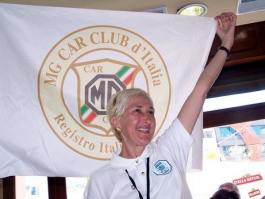 The lovely Carla of MG Italia waves goodbye as the MG enthusiasts leave a wonderful annual event. (Photo: Bob Owen) Disembarking at Patras after the long crossing from Italy with the two V8s of Gordon Hesketh-Jones and Bob Owen. (Photo: Bob Owen) We arrived at Ancona to meet up with the MG Italia group at 1605, just five minutes behind schedule due to two accidents on the autoroute, one a standard Italian tailgating shunt and the other a fire. There are 49 cars at the MG Italia this year with about four from the UK - two MGBGTV8s, an MGBGT and a TD. More accurate information later, or probably from Gordon Hesketh-Jones who has more statistics at his fingertips! The second brief report came as Bob was preparing to leave Greece after a wonderful MG Italia 2005 and prepares for the route back via Switzerland. Yes, all going well. - the car has been behaving well (except for the brake judder) and the new brake fluid sensor is working properly. It has been a very good trip with MG Italia - good organisation, good food, good weather, good company, good scenery, good wine - but all good things must come to an end and, after seeing Olympia today, we board the ferry to return to Ancona. Gordon and Jennifer will travel on to eastern Europe on the next stage of their extraordinary long distance trip. When the ferry lands in Italy we will make an autostrada dash for Milan where we'll spend two nights, courtesy of our prospective son-in-law (Italian) followed by a day in Switzerland with an old school friend who has lived there for thirty years and who I have not seen in all that time. I think more wine and reminiscence will be the order of the day. Then a couple of days sauntering through France before our Dover ferry on Friday. Bob's third report came on his return home. We all said our long goodbyes to the MG enthusiasts we had met on the MG Italia and then went our separate ways. We astounded our prospective son-in-law by arriving outside his apartment in Viale Papigniano in central Milan without recourse to sat nav, mobile phones or a police escort. In fact, we had had some tips from an MG Italia couple who lived in Milan plus some luck in finding the right streets - and I have to confess that Carolyn is a very good navigator! We sometimes reverse our roles but I usually get us lost! After a day and two nights in Milan we set off for our long lost friend's house in Durrenasch, near Zurich. All went well as we headed north over the Simplon pass and through spectacular mountain scenery with remnants of snow beside the road - this should have given us cause for concern - but we headed gaily on to the next smaller higher passes pointing towards Zurich - only to find all three possible passes closed. Now we either had to retrace our steps or take a long deviation west along the French border. Either way, we would be late and so needed to use motorways. But we had not got a Vignette (Swiss motorway licence) or any Swiss francs. So we had to stop in town where parking was not metered and find how to get a Vignette. Luckily I found a travel agent with customer parking and they directed us to the Post Office who fortunately took Euros. |
||||
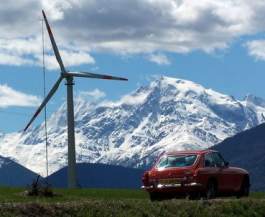 V8 parked alongside a wind turbine with a spectacular backdrop at the Passo di Resia in northern Italy at 3,000m. (Photo: Bob Owen) So at last we set off on the motorway, complete with our new sticker, keeping eyes open for the law and running at a nice steady 3,000 rpm (approx 87 mph) and rapidly eating up the miles. The route was less picturesque than our chosen route but at least we would not be too late. Wrong - was that the engine missing I felt? Perhaps I had inadvertently knocked the overdrive switch as I operated the indicators? Yes, all is well - but - hesitation again. Then running on four cylinders, then picking up. Was it a fuel problem? I managed to get to a service area, then checked there was fuel to the carburettors - none! So I removed the feed to filter and turned on the ignition - fuel. So the filter must be dodgy, but it looked fine. Strange, so I bypassed the filter and then set off again. Ten miles later, the same again happens again. The problem was an intermittent fuel pump. Who was the wise virgin who bought a spare petrol pump, just in case, but then proceeded to leave it in the garage at home? After stressful few miles, I pulled off for a small town and headed in looking for a small garage and luckily found one just about to close. As it was a French speaking area, my schoolboy French was brought into play. Yes, they would help if they could. Unfortunately they had never seen an SU petrol pump! So they said would I like to use their ramp and tools? I declined the latter as I had my own and then set about seeing if I could repair the pump. Six years and 30,000 miles ago I had the fuel pump in pieces to change the capacitor and re-adjust the contacts, although the contacts were not replaced, so I had vague memories of how to proceed. I turned the contact assembly through 180 degrees and re-assembled. No good so I disassembled it and turned it back through 360 degrees and re-assembled. Bingo! Quick clean up and back on the motorway. We arrived for dinner at Durrenasch at 10pm and our hostess, Monika, managed to serve us a delicious meal even though it was two hours after the due time. We drank plenty of wine and talked until two in the morning before collapsing into bed and instant sleep. |
We spent the next day in Durrenasch and then set out on Thursday morning for Cambrai. The car was going well but near St Dizier in eastern France we decided to leave the autoroute and head into town to find a pleasant place for some refreshment. Going south east on the N road we met an old MG - a dark red TD - "Blow me! It's Malcolm and Lynda!" I said. They had been with us in Greece but had spent a couple of days in Gabbice Mare and then Chamonix before heading home, mainly on the ordinary N roads. What a remarkable encounter! What were the odds of being on the same stretch of minor road at a random time in eastern France heading in opposite directions? We had a chat and resumed our respective ways. Back on the autoroute I felt a strangely familiar hesitation as we approached Reims. Pump again...so I found an Aire (service area) and put the car with the pump side wheels on a kerb to get clearance to slide under the back of the car. Fortunately it was daytime and dry, so I used old newspaper as a mat. This time adjustment would not solve the problem, so I released the fixed contacts and moved them so that a new area was contacting, then re-set them. Phew - the pump was working again. But we were due in Cambrai, 100 miles away, for a meal at 8pm. We were now late once again. We were making a habit of late dinners - but fortunately the lovely Babeth at Le Clos St Jacques came to our rescue, just as Monika had two nights previously, with another delicious meal. Again, more wine and chat followed by a deep sleep. Next morning I stocked up on wine from the Cambrai supermarket - 50 bottles and 11 wine boxes- and fumigating bombs for the greenhouse as EU rules means they are banned in the UK, but the French show their usual healthy disrespect for such things. The wine boxes and bottles go flat on the rear floor with the luggage on top; coats and pullovers etc provide packing and stop rattles. The space behind the seats and the passenger foot well are also used to provide further capacity. No problems getting to Calais or from Dover to our home near Reading. So a total distance of 3,200 miles in just under three weeks and a very enjoyable holiday. Sadly, the car blotted it's copy book a little, but in fact this is the first time I have had to get out and get under the V8 in five return trips we have made to Italy in recent years. Old cars may be less reliable than modern cars, but when they go wrong you do have a good chance of doing running repairs. When a modern car goes wrong you have a far slimmer chance of putting it right. There are great roads in France with much less traffic than in the UK - ideal V8 country! So go out and take your V8s to the continent, or beyond. |

